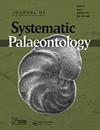Towards a unifying systematic scheme of fossil and living billfishes (Teleostei, Istiophoridae)
IF 2.2
2区 地球科学
Q3 EVOLUTIONARY BIOLOGY
引用次数: 2
Abstract
Extant istiophorids are open ocean apex predators that are extensively studied due to their ecological importance and high values for fisheries. Nevertheless, little is known about their evolution because of a fragmentary fossil record and extremely difficult taxonomy of fossil species. Here, we present a new phylogenetic hypothesis covering fossil and living istiophorids. Our results demonstrate that istiophorid richness is larger than previously assumed, comprising eight genera with 20 species. The phylogenetic analysis shows that istiophorids are grouped into four clades: the Istiophorus clade, which includes the sailfish; the Machairostra clade, which comprises Makaira spp., including two new species from the late Miocene (†Makaira colonense sp. nov. and †Makaira fierstini sp. nov.); the Gracilorostra clade, which comprise all remaining istiophorids with exception of spearfishes and includes two new genera and one new species (†Morgula donosochagrense gen. et sp. nov. and †Spathochoira calvertense gen. et. comb. nov.); and the Tetrapturomorpha clade is composed of the spearfishes and the extinct †Prototetrapturus courcelli gen. et. comb. nov. The family Istiophoridae shows an evolutionary trend toward reduction of the premaxillary thickness and increasing the extension of narial cavities. This reduction is related to an increase of adipose tissues in the rostrum base probably driven by the presence of the oleofera gland, an organ involved in feeding, healing, endothermy and hydrophobic functions. Our phylogeny shows a direct relationship between the rostral and cranial shape explained by body size and feeding behaviour. The larger istiophorids have lateral apophysis and the larger spines of the vertebral column. The spearfishes represent the smaller species of the family, with the extant Tetrapturus spp. first appearing in the late Pliocene. The clade Tetrapturomorpha shows an extreme size reduction over time when compared with species of their sister clade Gracilorostra, demonstrating an evolutionary trend towards size reduction. http://zoobank.org/urn:lsid:zoobank.org:pub:D3D3B15B-36FA-42EB-98AD-FAF369D989EB化石和活billfish (Teleostei, Istiophoridae)的统一系统方案
现存的异蝇类是开放海洋的顶端捕食者,由于其生态重要性和渔业价值而被广泛研究。然而,由于化石记录的残缺和化石物种的分类极其困难,人们对它们的进化知之甚少。在此,我们提出了一个新的系统发育假说,涵盖了化石和现存的异虫。结果表明,该植物的丰富度大于之前的假设,包括8属20种。系统发育分析表明,旗鱼纲可分为四个分支:旗鱼纲分支包括旗鱼;macharostra进化支,包括Makaira sp.,包括两个来自晚中新世的新种(†Makaira colonense sp. 11 .和†Makaira fierstini sp. 11 .);长尾鱼枝,包括除矛鱼外所有现存的剑鱼纲,包括两个新属和一个新种(†Morgula donosochagrense gen. et sp. 11和†Spathochoira calvertense gen. et. comb)。11月);四元形亚纲由矛鱼和已灭绝的†Prototetrapturus courcelli gen. et. comb组成。11 . Istiophoridae科表现出上颌前厚度减少和鼻腔扩展增加的进化趋势。这种减少与基底脂肪组织的增加有关,这可能是由油膜腺的存在所驱动的,油膜腺是一种参与进食、愈合、恒温和疏水功能的器官。我们的系统发育表明,喙部和颅骨形状之间存在直接关系,这可以通过体型和摄食行为来解释。较大的坐骨体具有侧突和较大的脊柱棘。鱼叉鱼代表了这个家族中较小的物种,现存的四爪鱼最早出现在上新世晚期。随着时间的推移,与姐妹分支Gracilorostra相比,四元形进化支显示出极度缩小的尺寸,表明了尺寸缩小的进化趋势。http://zoobank.org/urn:lsid:zoobank.org:pub:D3D3B15B-36FA-42EB-98AD-FAF369D989EB
本文章由计算机程序翻译,如有差异,请以英文原文为准。
求助全文
约1分钟内获得全文
求助全文
来源期刊
CiteScore
5.30
自引率
7.70%
发文量
31
审稿时长
>12 weeks
期刊介绍:
The Journal of Systematic Palaeontology publishes papers that provide novel and impactful results in phylogenetics and systematics and that use these results in ways that significantly advance rigorous analyses of palaeogeography, palaeobiology, functional morphology, palaeoecology or biostratigraphy. Papers dealing with theoretical issues or molecular phylogenetics are also considered if they are of relevance to palaeo-systematists. Contributions that include substantial anatomical descriptions, descriptions of new taxa or taxonomic revisions are welcome, but must also include a substantial systematics component, such as a new phylogeny or a revised higher-level classification. Papers dealing primarily with alpha-taxonomic descriptions, the presentation of new faunal/floristic records or minor revisions to species- or genus-level classifications do not fall within the remit of the journal.

 求助内容:
求助内容: 应助结果提醒方式:
应助结果提醒方式:


